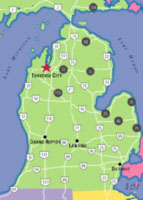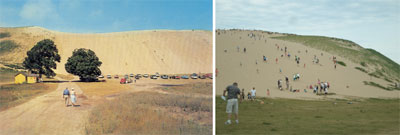
Vol. XIV, No. 10, December 2014
- Editor's travelogue
- Last chance to save $100 on FEC education for success, nothing less
- Trends for 2015
- White Paper - The Perfect Storm: LBE disruption & opportunity
- The great beer abandonment
- Arcade bars
- 35 million households visited an agritainment farm this summer and fall
- Understand who your competition is
- Chuck E. Cheese's goes educational
Editor's travelogue

An increasing percentage of our company's work deals with the food and beverage aspect of location-based entertainment venues. This not only includes designing and producing destination dining and food service for our entertainment-oriented projects, but also working with agritourism farms. Recently I visited Traverse, Michigan to work with a farm on the development of a sustainable culinary agritourism project.
Traverse City is located in the upper West side of Michigan at the southern end of the two arms of the Grand Traverse Bay that connects to Lake Michigan. In addition the many outdoor recreational activities the region offers and the region being the largest producer of tart cherries in the U.S., the Traverse City area is known as a culinary tourism destination. Bon Appetite magazine named Traverse City as one of America's "Five Top Foodie Towns”. There are more than 100 restaurants, many featuring local and sustainable selections, 41 wineries and tasting rooms, 15 microbreweries and taprooms, one distillery and tasting room, four cider houses and tasting rooms and a tea farm.
I continue to be amazed and surprised by the diversity of America's geology. While touring the region for research on the culinary agritourism project, our client took me to Sleeping Bear Dunes National Lakeshore, located just a short drive west of Traverse City on a 35-mile section of the eastern shore of Lake Michigan.
The park is named after a Chippewa legend of the sleeping bear. According to the rather sad legend, an enormous forest fire on the western shore of Lake Michigan drove a mother bear and her two cubs into the lake for shelter, determined to reach the opposite shore. After many miles of swimming, the two cubs lagged behind. When the mother bear reached the shore, she waited on the top of a high bluff. The exhausted cubs drowned in the lake, but the mother bear stayed and waited in hopes that her cubs would finally appear. Impressed by the mother bear's determination and faith, the Great Spirit created two islands (North and South Manitou islands) to commemorate the cubs, and the winds buried the sleeping bear under the sands of the dunes where she waits to this day.
Good Morning America named the Sleeping Bear Dunes National Lakeshore as their Most Beautiful Place in America.
The dunes are totally unexpected as well as spectacular. They rise almost straight up from the edge to Lake Michigan to 450' at their highest point. Yes, you read that correctly, the highest point is four hundred and fifty feet above the water level.


Sleeping Bear Dunes
The dunes were formed during the Ice Age when continental glaciers spread southward from Canada repeatedly burying the area under ice. Those massive glaciers enlarged river valleys and carved out the wide, deep basins of the Great Lakes. They also created "Perched Dunes" which are dunes formed by glacial sands deposited on plateaus high above the shore. The Sleeping Bear Dunes are an easily accessible, beautiful example of this type of dune.
In November, I was a presenter at the IAAPA seminar on Growing Your Revenue with Adults. I had a standing room only audience. This month in our enewsletter, we have White Paper that includes a lot of the research that we presented at the seminar plus additional new information. We also have a number of other interesting articles, ones you won't find in any other industry magazine or newsletter. And don't forget, there are only a few days left to save $100 by registering for the upcoming Foundations Entertainment University in Phoenix January 20-22.
Hope you have a joyous holiday and prosperous New Year.

Vol. XIV, No. 10, December 2014
- Editor's travelogue
- Last chance to save $100 on FEC education for success, nothing less
- Trends for 2015
- White Paper - The Perfect Storm: LBE disruption & opportunity
- The great beer abandonment
- Arcade bars
- 35 million households visited an agritainment farm this summer and fall
- Understand who your competition is
- Chuck E. Cheese's goes educational


